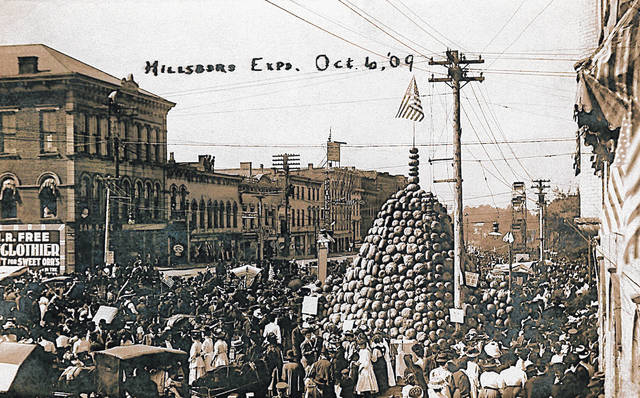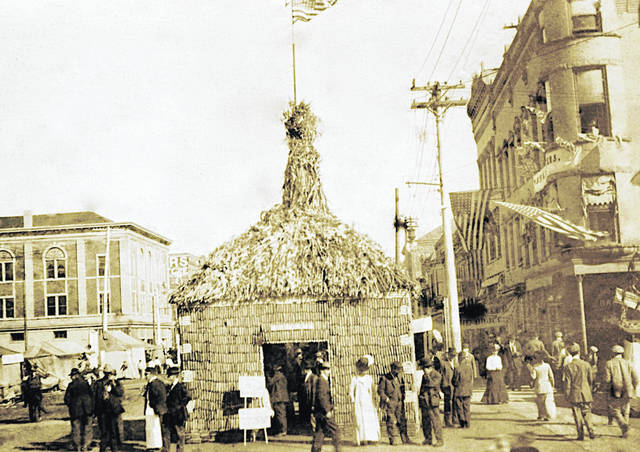

Editor’s Note — On March 15 this year The Times-Gazette published a postcard photo of the “Punkin Palace” from what was called the Hillsboro Expo in October of 1909. There was little information about the photo at the time, but Christopher S. Duckworth, who has family ties to Hillsboro and Greenfield, was able to provide more detailed information. Duckworth spent three decades at the Ohio Historical Society, where he was founding editor of Timeline magazine, followed by another 10 years at the Columbus Museum of Art. Today, he owns his own publishing company, Brevoort Press LLC.
In an email to The Times-Gazette, Duckworth wrote: “I was rather surprised to read the piece about the Punkin Palace in The Times-Gazette. You see, I have had an interest in the subject for years, and I have collected the photo postcards and news clippings of it. I have been intending to write an article about it, but alas other projects have precluded my best intentions. However, when John Glaze and I revised ‘The Hillsboro Story,’ we included a photograph and news clipping.
“… I think that the palace first made its appearance in 1907, and I am not certain whether this took place every year or for how long. Note that a corn palace also was featured at least once.
“My interest was piqued several years ago by a postcard that I have labeled Pumpkin Card Front and Pumpkin Card Back. You see the emboss of ‘AYRES’ STUDIO, HILLSBORO, OHIO’ on the card. This was my great-aunt, Sarah Ella “Byrde” Ayres’, studio located on North High Street… I purchased this postcard on eBay. When it arrived, I was stunned to discover that it was addressed to Escoe Ervin at 101 Brevoort Road, Columbus, Ohio.
“In 1951, my family (I was two years old) moved into 63 Brevoort Road. Growing up I came to know Escoe Ervin and his wife, Maude, quite well. In fact, I store my car in their garage. Today, my wife and I live in the house at 63…small world.
“… Hopefully, all this will answer some your readers’ questions.”
Among the items Duckworth shared was a copy of an add from the Sept. 30, 1909 edition of the Hillsboro News-Herald. It reads: “For home made pumpkin pies go to the Punkin Palace. H.J. Schweinsberger has secured the privilege of selling soft drinks, pop-corn and candies in the Punkin Palace. A force of men commenced the constructing of the ‘punkin palace’ for the Fall Exposition Monday. It will be located on the corner of the public square next to the Merchants’ National Bank.”
But what really explains the Punkin Palace is a newspaper clipping of a story Duckworth shared from the Nov. 24, 1959 edition of the Hillsboro Press-Gazette. It includes an editor’s note and is reprinted below in its entirety as it appeared in this newspaper almost 60 years ago:
“Editor’s Note: The following account of once-popular ‘street fairs’ at Hillsboro was found in the November 18, 1909 issue of the National Stockman and Farmer publication. It was submitted by Mrs. Harry Stoltz, Hillsboro Rt. 4.
“We have had two very successful street expositions in our town (Hillsboro) and these expositions and their success were due to the efforts of the Hillsboro Business Men’s Association and to the many others who co-operated to make these affairs a success. Premiums were offered for fine livestock, poultry, grains, fruits, vegetables, fancy work, etc. Bands, fireworks, parades, and other features and attractions were provided and as no admission was charged large crowds were in attendance. Just imagine the horse races taken out of the usual county fair and the remainder set down on the streets of a commodious little town of 6,000 people and you have a good idea of what these expositions are.
“The entire cost ($1,700) of the exposition, with the exception of $500 realized from the sale of privileges, is borne by the business people and public-minded citizens. These expositions encourage more cordial relations between the town and country people, and the merchants who contributed consider the money paid as an investment in an excellent kind of advertising and that the good results will come in during the entire year rather than during the time of the exposition, though at such times trading was exceptionally heavy in all lines.
“A pumpkin palace was one of the unique attractions. It cost about $30 to build, which was paid by the sale of privilege to sell refreshments inside. A 6-sided frame of lumber was made, spikes were driving into the outside to hold the pumpkins in place, and the spaces between were covered with green paper, making a rather pleasing appearance. (It looked like a 20-foot teepee covered with pumpkins and topped by Old Glory). Post cards of the palace were made and placed on sale during the three days of the exposition and so popular was the pumpkin palace that 2,000 of the cards were sold. — W.E. Duckwall.”



